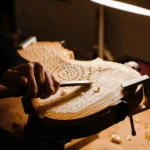Top Cello Makers in 2023
Back to BlogTop Cello Makers in 2023
Who are the top cello makers in 2023? We are here to tell you all about that. Let’s start by talking about this beautiful instrument. The violoncello, also known as the “cello,” is an instrument with over 400 years of history and belongs to the family of stringed instruments, similar to the violin, despite its size. The cello is becoming increasingly popular and is used in classical music cello performances and in many jazz, rock, and other music styles. The cello originated in Italy in the 17th century and was manufactured by the most important luthiers of the time, who also produced violins, such as Andrea Amati, Paolo Maggini, and Gasparo Bertolotti, among others.
Cello makers in Italy
Italy has a long tradition in cello making dating back to the 16th century when significant luthiers in Cremona and Brescia virtually dominated the market. At the same time, luthiers were generally foreigners from northern Europe in various other Italian cities. Among the most important were Platner, Sellas, Tecchler, and Goffriller. Tecchler was undoubtedly one of the most significant, producing cellos with a distinctive appearance and extraordinary quality.
Bologna in Italy was one of the most important centers for developing cello music. Great cello composers like Domenico Gabrielli, Giovanni Battista Degli Antonii, and Giuseppe Maria Jacchini wrote many pieces for this instrument. Bologna was also significant around 1660 in string production, being the first to produce wound gut strings. The country’s tradition continues today, and Italy is undoubtedly a significant exporter of the world’s finest instruments and home to the greatest cello makers.
Italian cello makers: a rich legacy
In a painting by the Italian artist Gaudenzio Ferrari, dated 1546 and titled “Concert of the Angels,” we can observe these messengers of God singing and playing some string instruments, including a cello. However, it had only three strings.
By the 17th century, the cello gained significant importance in the music created by the best composers of the time, and in the following century, compositions specifically for this instrument emerged. Afterward, the cello continued to evolve into the instrument we are familiar with today, but its overall shape and design have remained untouched since then.
Over time, some modifications were introduced in the way of playing and the instrument’s design, making it even more harmonious. The cello became popular and is now integral to all world symphony orchestras. Because of that, cello makers all over the world are ready to create beautiful and well-sounding instruments to keep the music going! And Italy and Italians, as we know, have a huge legacy to carry and be proud of.
Cello makers: The work of luthiers
Luthiers are highly specialized professionals in constructing string instruments with resonating boxes. Cellos initially had five strings as a string instrument, but today, they have only four strings. The construction of a cello is quite complex, requiring specific types of wood. Willow or poplar is used for the sides of the instrument and the neck. The soundboard is usually made of spruce.
The best cello makers do the construction process by hand, using special tools and forms to give the correct curvature to the wood. The cello produces deep and powerful musical notes. Its construction is intricate and challenging even for experienced cello makers, and things like the varnish applied to the wood are crucial for the quality of the final product.
The varnish is directly connected to the cello’s sound. It needs to be elastic to follow the wood’s movement and allow it to vibrate. Its second function, equally important, is to protect the instrument. There are several excellent cello makers today, and we want to introduce you to a special one: Luiz Amorim. Luiz produces quality instruments played by the world’s most important cellists.
Cellos as versatile instruments
Many great composers dedicated themselves to writing music for the cello, including Antonio Vivaldi, Haydn, Beethoven, Luigi Boccherini, Prokofiev, Jean-Baptiste Barrière, Bach, Felix Mendelssohn, and countless others.
The cello is not limited to classical music alone. It played a fundamental role in jazz, and among the important names, we cannot forget Ron Carter, Oscar Pettiford, Ernst Reijseger, and Abdul Wadud.
During the 20th century, prominent cellists such as Pablo Casals, Yo-Yo Ma, Mstislav Rostropovich, Paul Tortelier, Jacqueline du Pré, and Sol Gabetta emerged.
Is it worth investing in a quality cello?
Currently, there are various cello makers producing quality cellos. Cellos made by these masters are not usually accessible to everyone, but there is always the option of buying a second-hand cello to start learning and gain experience and a love for sound.
Cellos come in various sizes to accommodate all ages, ranging from 1/8 size for children to full-size (4/4) cellos.
The most critical aspect of this instrument is the sound, and attention should be paid to the materials used in its construction. As mentioned, acquiring a good cello comes with a cost. Still, obtaining a well-manufactured industrial instrument or opting for a second-hand one that offers the necessary quality at a reasonable price is possible. The important thing is to start!
The cello is one of the most important string instruments and is present in any major orchestra.
Learning it requires a lot of practice, but even without a teacher’s help, progress is possible, and playing it can be enjoyable. It is an instrument that can be practiced by people of all ages and is very beneficial for relieving stress, improving motor coordination, and, most importantly, creating music that transcends barriers and brings immense satisfaction.
If you are interested in or love the sound of the cello, find out more about the instrument and consider the investment; always search for the best cello makers.









